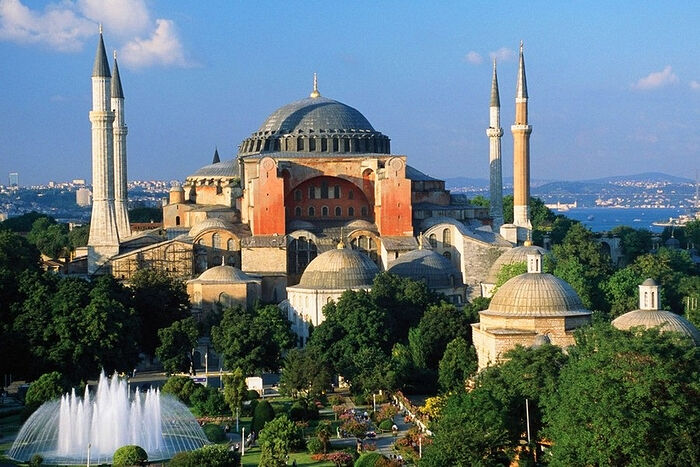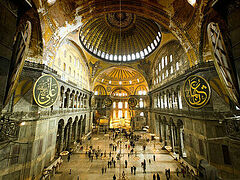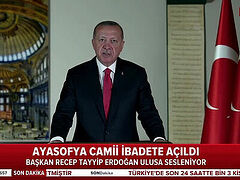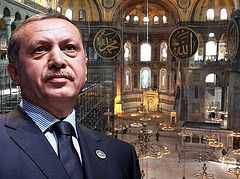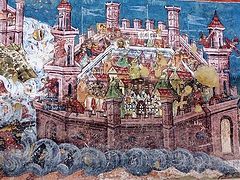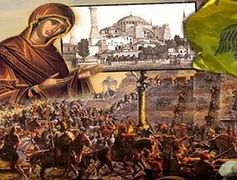The fifteen hundred year history of the Hagia Sophia has recently seen the beginning of a new era. In the distant past the conversion of it from an Orthodox cathedral into a mosque also coincided with the beginning of a new era. There are different views on what chronologically marks the end of the Middle Ages and the beginning of the Modern Age, but the most convincing and more or less commonly agreed upon is the year 1453 when Constantinople fell, having been conquered by the Ottoman Turks. The capital of the Orthodox Empire became the residency of the Ottoman sultan Mehmed the Conqueror. He turned the Cathedral of the Constantinople Patriarchate into a mosque. In 1934, at to the command of the founder of the Turkish Republic Kemal Ataturk, the Hagia Sophia became a museum, and now by the decree of the president of Turkey Erdogan, it's status was changed once more—it has turned into a mosque again.
This change was received with bitterness by the Orthodox world, Christians of different confessions, and the cultural community. For Russian Orthodox people the Hagia Sophia is especially dear because the equal-to-the Apostles Grand Prince of Rus' Vladimir's envoys visited it and reported, "We do not know whether we were in heaven or on Earth because there is no such sight or beauty on Earth, and we are not capable of describing it; we only know that God dwells with people there." Their story about what they saw and what they experienced while being in this church served as a trigger for the prince to decide on his own baptism and the baptism of his people.
In the current situation it is necessary to adequately and soberly assess the nature and the scale of the suffered loss. The unsurpassed creation of the great architects Anthemius of Tralles and Isidore of Miletus was not destroyed by the presidential decree. Sophia's mosaics were saved, amongst them are the masterpieces representing the highest achievements of Christian art. On the other hand, even when the Hagia Sophia had the status of a museum, there was still no place in it for public prayer or for the Orthodox divine services, and the preceding status of a mosque did not stop Christian pilgrims from praying heartfelt or mental prayer in this shrine.
In all fairness one should remember that the Ottoman Turks were not the first ones who dared to encroach on this shrine. In the eighth century, the church survived the onslaught of the iconoclasts, who hammered the mosaics off its walls. At the beginning of the thirteenth century, crusaders robbed the cathedral. In of their wild ignorance they imagined that the mosaics were made of gold and so they cut them out with their axes. And finally, two centuries later, when the church became a mosque, the long-suffering mosaic panels that covered the walls of the temple were scraped off or plastered over. The preserved mosaics behind the plaster were discovered during restoration work carried out in the museum period of the temple.
Despite the suffered losses, the Hagia Sophia to this day remains the greatest creation made by man—it still bears the reflection of the heavenly world, visible signs of touching Divine perfection. The Russian artist Mikhail Nesterov visited the Hagia Sophia Temple when it was a mosque, and was greatly impressed by what he saw. He wrote:
“The Hagia Sophia does not seem grandiose from the sea but is enormous up close. A cluster of later added Muslim extensions distort its original form. However, as soon as you enter the temple everything changes ... almost at the very entrance ... you can see almost the entire vault of the dome, which is so resembles the vault of heaven. Its boundlessness is the boundlessness of the sky, something that of course cannot be said about the Roman St. Peter's Basilica, which is so heavy and oppressive... The vastness of the dome of the Hagia Sofia, its seeming limitlessness, simply amazes.”
The bitterness felt by Christians about the Turkish president’s decree is natural, but the reaction of the Orthodox world at the Hagia Sophia’s change of status cannot be the one expressed in a statement issued on this occasion by the leadership of the World Council of Churches. The statement describes this act by Erdogan as "a blow to the unification of religions". Perhaps an unfortunate expression was chosen and what they really meant was that despite belonging to different religious communities, there is a solidarity of people in defending some common values. The "unification of religions" is a harmful utopia that only people who are far from religious faith want to achieve.
But what will become of the Hagia Sophia when the implementation of the Erdogan's decree will take shape? The Turkish side made assurances that access to the Hagia Sophia will remain open and free as it has been before. The pessimists and the sceptics say that this is just the beginning... But a realistic view on the situation does not give grounds (at least in the near future) for such fears, as having become a mosque, the temple will not be closed off from visits by "infidels".
The main concern today is about the preservation of Sophia's mosaics. The traditional intolerance of Islam, as well as of Judaism, towards the sacred images in prior years went much further—as far as forbidding all figurative art so that artistic talent could only be expressed in an inexhaustible ingenuity of creating ornamental decorations. Modern Turkey has gone a long way from its former idiosyncrasy concerning images—for images are present in its cities and villages at every step—and perhaps there isn't a city that hasn't been decorated with a statue of Kemal Ataturk. But in a mosque, just as in the old days, no sacred or other figurative images are allowed. With the conversion of the Hagia Sophia into a mosque, of course, decisions will be made in this regard. What these decisions will look like is not yet clear. However, official assurances were made that the regime of protection of monuments as anticipated by UNESCO for the World Heritage sites (the Hagia Sophia being recognized as one in 1985) will be strictly observed in the future. This regime excludes not only the destruction of the building itself, but also any damage to the protected masterpieces of global importance. In this respect, it would be a good outcome if the changes would be limited to the covering up of the mosaic panels for the duration of the Muslim prayer. As of today, there are no signs of the monstrous prospect of the destruction of the Sophia's mosaics; the moderate Islamism that influences modern Turkey today stands far away from the vandals of Isis, Al Qaeda or the Taliban.
There is a wise proverb—don't go waving your fists after the fight. But analyzing the causes of defeat for the sake of learning lessons for the future is always useful and appropriate. There are at least two factors that influenced the decision-making on this change so unfortunate for us Christians.
One of them lies far from the Christian and cultural community efforts trying to prevent what has taken place. The roots of this factor can be found inside the very Turkish society itself, or it would be more accurate to say that it is driven by how gradually, step by step, the reaction of society has changed towards the prolongation of the process of integration of Turkey into the Western European community—its integration into the EU, to be precise. Something similar could be observed in yesterday's Catholic and Protestant, but now post-Christian Western world and its relationship with other countries and the people of those countries who have sought or are still seeking to enter this “privileged” part of the world. Illusory hopes give way to disappointment. The twists and turns of this novel are well known to us Russians, as we have experienced portions of it in our own not so distant history. An illustration of this process is the trivial image of being lured by a carrot that cannot be reached. The collective West, despite not having a shortage of critically thinking people, is convinced of its superiority over other civilisations and of its irresistible attractiveness to the rest of the world. But in reality, there is a limit to this attraction. This temptation is not to everyone's taste. Had Turkey finally become a post-Muslim society, like the post-Christian West, it would have been accepted into the EU; but this did not take place and so Turkey was not accepted. As a result, the position of the principled opponents of Westernization was strengthened because it received the support of Turkish people, who became disillusioned with the idea of fraternization with the West. President’s Erdogan decree is a symbolic gesture addressed to the West, because in the Muslim world the West is often mistakenly associated with Christianity; but in reality, the cradle of Christianity is not located in the West, but in the East—in Palestine. The Hagia Sophia was under the rule of crusaders, that is, the "West" for just a little over a century.
Another factor which prompted the decision to convert the Hagia Sophia Temple into a mosque at this moment in time is a crisis of relations within the Orthodox world. The Phanar put itself in opposition to the Russian Orthodox Church by committing an act of jurisdictional aggression. One of the consequences of the split we are witnessing today is the changing status of the Hagia Sophia. Had there been real solidarity in the Orthodox world, Ankara would have found it harder to brave such a step. In fact, until recently, the Patriarch of Constantinople, with the consent of the patriarchs and the episcopate of various countries autonomous Orthodox Churches, could have made appeals on behalf of three hundred million Orthodox Christians. As a result of his actions it became impossible to preserve the canonical communication between him and the Russian Orthodox Church. So who does he represent now? Turkey has at most a few thousand people belonging to the Patriarchate of Constantinople, and the voice of the Ecumenical Patriarch whose see is in Constantinople, was not heard by the state authorities of the country that falls under his jurisdiction.
But the other truly authoritative voices of people who spoke out from abroad for the preservation of the previous status of the Hagia Sophia were ignored in Ankara under the pretext of national sovereignty. Supporting the schism comes at a high price, and it may get higher over time. Phanar's frailty can provoke further, perhaps more tangible moves. Should that take place, it remains to be seen whether the Constantinople Patriarchate will be protected by the powers in whose geopolitical games it participates on the territory of Ukraine. But today, the Patriarchate has plenty of its own problems.

